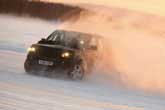Recent Articles
Popular Makes
Body Types
2006 Range Rover Sport First Drive
Land Rover pimps its ride
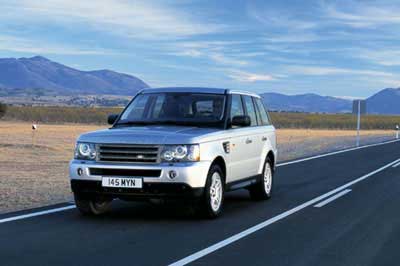
MOAB, Utah – Land Rover is known worldwide for creating trucks that handle the toughest-of-the-tough, from the greenways and thick mud of England’s Eastnor Castle to the bone-jarring tracks and inhospitable outback of interior Australia. To date, automakers that specialize in cars rather than trucks have created the niche-oriented high-performance sport-utility vehicles craved by American up-and-comers, companies like BMW and Mercedes-Benz and Porsche. With the new Range Rover Sport, however, it could be said that Land Rover has taken a different approach to the performance-utility market by first gaining a master’s degree in off-road prowess and later a Ph.D. in premium luxury. Now, this British company, known for some of the most capable and confident bush wackers and a member of Ford Motor Company’s Premier Automotive Group (PAG), is ready to enter the rapidly growing luxury-sport segment of the SUV marketplace that is dominated by BMW and Porsche, with its all-new 2006 Range Rover Sport. Our evaluation of the new Range Rover Sport included an intense four-wheel-drive trail in Moab, Utah, one of the best-known locations for four wheeling in the U.S. The course included a rich mix of off-pavement terrain, along with an aggressive and technical rock hill climb known as “Wipe Out.” But what blew our backcountry boots off our test-driving feet was the 275-mile drive from Aspen, Colorado to Moab. For it was throughout this drive day that we were able to evaluate and push the limits of the two versions of this new model – the naturally aspirated and sprightly Range Rover Sport HSE, and the higher-powered Range Rover Sport Supercharged.
Model Mix
Model Mix Within the Land Rover family, the Range Rover Sport fits – at least in terms of price– squarely between the Land Rover LR3 and the recently updated, full-size Range Rover. The HSE starts at $56,750 and the Supercharged runs $69,750. Land Rover offers two 2006 Range Rover Sport models: the HSE and the high-performance Supercharged, each powered by a V8 engine. Standard amenities for the HSE include eight-way power adjustable front seats, dual-zone climate control, a six-airbag supplemental restraint system including side curtain protection, bi-xenon headlights, DVD navigation, a power sunroof, and a Harman/Kardon six-disc stereo system with 13 speakers. Supercharged models get a boost, literally, from a Roots type supercharger bolted to the V8 engine. Adaptive front lighting, a unique grille, different seating surfaces, chrome exhaust outlets, power vents on the fenders, and a standard Cold Weather Package distinguish the Supercharged Sport from the base HSE. Notable options on each include adaptive cruise control and a Rear Seat Entertainment Package, which adds a six-disc DVD player and two 6.5-inch LCD screens embedded into the rear of the front seat head restraints. Other available packages include a Cold Climate Package (heated front and rear seats, heated front windshield, and heated windshield washer jets) and a Luxury Interior Package (Cold Climate Package plus premium leather seats, adaptive front headlamps, and wood trim). The Range Rover Sport is available in ten exterior colors, plus the Limited Edition Vesuvious (a burnt orange, like in the top photo, in case you’re wondering), and four interior schemes that Land Rover insists on calling ‘colorways,’ including an Ivory seats/Ebony carpet interior that’s available only in the Supercharged model. Within the Land Rover family, the Range Rover Sport fits – at least in terms of price– squarely between the Land Rover LR3 and the recently updated, full-size Range Rover. The HSE starts at $56,750 and the Supercharged runs $69,750. And though you might think the Sport looks the same size as these models, it is shorter than both, trailing the LR3 by 2.4 inches and the Range Rover by 7.2 inches. Likewise, the Range Rover Sport’s wheelbase is more than five inches tighter than its family members.
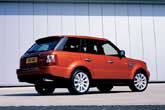
Nuts and Bolts
Nuts and Bolts Choose between a 300-horse HSE model or a 390-horse Supercharged edition. Either way, the 2006 Land Rover Range Rover Sport comes with permanent 4WD, stability control, and a height-adjustable suspension. Though smaller than both of its corporate siblings, the 2006 Land Rover Range Rover Sport gets the same set of engines as the range-topping Range Rover. Base Range Rover Sport HSE models have a 4.4-liter V8 with Variable Camshaft Phasing controlled electronically by the throttle. This unit generates 300 horsepower and 315 lb.-ft. of torque. Originally, this motor was developed from an existing Jaguar powerplant (a stablemate in the PAG), and is engineered for the rigors of severe off-roading duty. Supercharged models get a Roots-type supercharger added to the V8, the displacement of which decreases to 4.2 liters as a result of different cylinder liners designed to withstand the extra boost. The bore has been narrowed, but the stroke of the cylinders remains the same. An output of 390 prancing horses and 410 lb.-ft. of torque contribute to the Supercharged model's top speed of 140 mph. In contrast, the HSE reaches a maximum velocity of 130 mph. A six-speed automatic transmission determines gearing and is the only gearbox offered on the two 2006 Range Rover Sport models. This “intelligent” transmission includes adaptive mapping, to accentuate performance, as well as Command Shift operation, which will give you complete manual control – until you run it into the redline, that is. For a sporty feel, the shift lever sprouts from the forward portion of the center console and is canted toward the driver. Permanent 4WD is bundled with Electronic Traction Control (ETC) and Dynamic Stability Control (DSC). These systems work in tandem with the throttle, transmission, brakes, and suspension to maximize traction. New is Active Roll Mitigation (ARM), which helps stabilize the vehicle when loads threaten an imbalance. ARM employs engine-powered hydraulic pumps to help keep the Range Rover Sport level and from leaning excessively when cornering. Supercharged models get this feature as standard equipment; HSE versions enjoy it optionally. Note that ARM is automatically disengaged when you are in low range and traveling over technical terrain with extreme approach and departure angles to reduce unnecessary suspension movement. A standard height adjustable air suspension raises and lowers the new Range Rover Sport, allowing it to ford more than 27 inches of standing water while also easing entry and exit. Four-wheel-disc antilock brakes are sized 13.3- and 13.8-inches front and rear, respectively, in the HSE. For the Supercharged model, the discs are oversized, with 14.2-inch rotors up front and 13.8-inch plates in the back. Additionally, the Supercharged model’s four-piston front calipers are made by Brembo, a company renowned for producing effective racing brakes. These huge Supercharged-stopping binders fit inside 20-inch aluminum alloy wheels dressed in 275/40R20 rubber. Range Rover Sport HSEs ride on 19-inch rims and 255/50R series tires.

Design
Design Likely be voted More Likely to Succeed with the image-conscious club-hopping crowd and entrepreneurial set, the 2006 Land Rover Range Rover Sport is based on Land Rover’s attention-grabbing Range Stormer concept Likely be voted More Likely to Succeed with the image-conscious club-hopping crowd and entrepreneurial set, the 2006 Land Rover Range Rover Sport is based on Land Rover’s attention-grabbing Range Stormer concept, but with better flow and a more tapered appearance. From the outside, you’ll immediately notice that several of the 2006 Range Rover Sport’s styling cues were derived from its big brother, the Range Rover, particularly in details such as the intersecting dual-circle headlights, front fender mounted side vents on the Supercharged model, and ‘floating’ body-colored roof. Land Rover describes the roof as ‘floating’ because no body color panels exist between the beltline and the cap. The roofline also tapers back, lessening the “executive effect” created by the Range Rover’s upright and level ceiling. By tapering this contour on the Sport, Land Rover’s engineers say better aerodynamics are achieved; the new model has an impressive .36 co-efficient of drag compared to .39 for a Range Rover. For us, the profile is attractive and reminiscent of the 80’s Range Rover Classic. Like many other automakers that portray their models as “looking fast,” Land Rover designer Jeff Upex has sketched the Sport to appear like it’s in motion even when standing still. To our eyes, this slickness works, accentuated by the steeply raked windshield, the short front overhang, and the long rear overhang. One differentiator between the Range Rover and the Range Rover Sport Supercharged is the fender vents. The ‘gills’ on the Sport Supercharged are smaller and, we think, more attractive than those on top-of-the-line Range Rover. Stepping inside the Range Rover Sport, you’ll find your body snugly cosseted in standard power-adjustable seats for both the driver and front passenger, creating command seating that is more race-inspired than patterned after luxury vehicles. Thick bolsters provide lateral support, although seat contouring in the rear is reserved only for the outboard positions. Despite the tapered roofline, the rear headliner has been scooped out to maximize headroom. Four different fabrics in four colors are available for the seats, along with high-grade leather. Unique ‘sparkle’ leather is standard on Supercharged versions of the 2006 Land Rover Range Rover Sport. The rear seats split and fold asymmetrically, creating a commendable 71 cubic feet of cargo room to stow bikes and ski gear. You’ll also notice that while the cockpit retains some of the Range Rover’s upscale design cues and materials to connote luxury and loveliness, you’ll find the Sport’s circular analog gauges, ringed with metallic bezels, grouped into a binnacle and clearly sport-oriented. A large center console sits high and also curves towards the driver, enhancing the driver-centric cockpit feel.
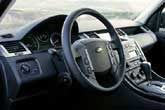
Safety and Technology
Safety and Technology Just because the 2006 Land Rover Range Rover Sport is engineered to go fast on paved roads and blaze trails where few can tread, that doesn’t mean that safety and technology take a back seat. Just because the 2006 Land Rover Range Rover Sport is engineered to go fast on paved roads and blaze trails where few can tread, that doesn’t mean that safety and technology take a back seat. For example, in the event of a collision, the driver and front passenger are protected by front airbags and thorax-protecting side-impact airbags that deploy from the front seats. Additionally, all outboard passengers are protected by a side curtain canopy that deploys from the roof. Impacts also prompt the engine and fuel system to shut down, the doors to unlock, and the emergency flashers and interior lights to illuminate. To keep the Range Rover Sport stable and highly maneuverable on a wide variety of surfaces, Land Rover’s Terrain Response system, also used to critical acclaim in the LR3 and Range Rover, is included on the Sport. Five settings can be selected by twisting a large, center-console mounted rotary knob. A general setting handles everyday, dry-pavement driving, while another addresses slippery and traction-compromised conditions created when traveling over grass, gravel or snow. Finally, three different modes are reserved for true off-roading: one for mud and ruts, one for sand, and one for intense rock crawling. Once set, the system modulates ride height, engine torque response, traction control, Hill Descent Control, and all gearing.
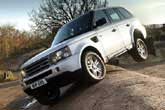
Driving Impressions
Driving Impressions Faster than any other Land Rover on its feet, the Supercharged model hits 140 mph, and goes from zero to 60 mph. in 7.1 seconds. The six-speed ZF transmission is especially pleasing in manual mode, which blips the throttle for downshifts. We split our on-pavement ride and drive of nearly 300 miles between the 2006 Range Rover Sport HSE and Range Rover Sport Supercharged models. While the Supercharged version benefits from a significant power boost and covers wide-open pavement in a mannerly fashion well into the triple digits, the HSE is no slouch. The Supercharged is given a more meaty exhaust note, but hard throttle on the HSE also brings a pleasant reverberation of power. Both versions of the Sport benefit from smooth aerodynamics and are laudably free of wind noise at speed. Faster than any other Land Rover on its feet, the Sport Supercharged hits 140 mph, and goes from zero to 60 mph. in 7.1 seconds. The six-speed ZF transmission, from PAG’s Aston Martin division, is pleasant to drive in automatic mode but especially so in manual mode, which adds a positive torque feature on downshifts that blips the throttle between gears. More aggressive looking and more fun to drive than any other Land Rover, both Sport models have a four-wheel independent suspension cross-linked with four-corner air suspension, and an active anti-roll bar that is hydraulically fed, with accelerators that anticipate cornering force and dial a bit of roll. In practice both on and off the road, driving the Range Rover Sport incurred little head or body roll. Speed-proportional, variable ratio ZF steering is highly responsive with 3.1 turns lock-to-lock and a turning circle of 38.1 feet, while the brakes offer effective stopping power. For us, there were no surprises driving the Range Rover Sport in a slow-speed fashion on the red rock trails of Moab. We were familiar with Land Rover’s permanent 4WD, two-speed electronic transfer gearbox, and Terrain Response systems from an in-depth evaluation of the LR3. Despite its on-road bias, the Sport has been engineered to meet all of Land Rover’s off-road testing criteria: a water fording to a depth of 27.6 inches; the ability to climb and descend 45-degree gradients; stability when driving across a 35-degree slope; and a handbrake that will hold on a 45-degree slope.
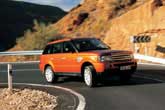
Wrap-Up
Wrap-Up Land Rover journeys into a segment it has never entered before, hoping to attract new buyers it has never known before, by adding attributes and a new dimension to its product line it has never expressed before. The 2006 Range Rover Sport is a new expression of Land Rover. This British automaker, with a 4WD-exclusive portfolio of models, has made its calling card going into the hinterlands beyond the beyond. Now, its journeys are to a segment it has never entered before, hoping to attract new buyers it has never known before, by adding attributes and a new dimension to its product line it has never expressed before. Range Rover Sport’s new paved road performance attributes and high-speed driving dynamics definitely push the boundaries for Land Rover. What a rush!
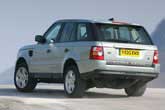
Specifications
Specifications The 2006 Land Rover Range Rover Sport’s main competitors include the BMW X5 4.8is, Cadillac SRX V8, Infiniti FX45, Jeep Grand Cherokee SRT-8, Mercedes-Benz ML500, Porsche Cayenne, Saab 9-7X, Volkswagen Touareg V8, and Volvo XC90 V8. Test Vehicle: 2006 Land Rover Range Rover Sport Price Range: $56,750 (HSE); $69,750 (Supercharged) Engine Size and Type: 4.4-liter V8 (HSE); 4.2-liter supercharged V8 (Supercharged) Engine Horsepower: 300 at 5,500 rpm (HSE); 390 at 5,750 rpm (Supercharged) Engine Torque: 315 lb.-ft. at 4,000 rpm (HSE); 410 lb.-ft. at 3,500 rpm (Supercharged) Transmission: Six-speed automatic with manual interactivity Curb weight, lbs.: 5,468-5,702 lbs. (HSE); 5,671-5,764 lbs. (Supercharged) EPA Fuel Economy (city/highway): 15/25 (HSE); 14/24 (Supercharged)(estimated) Length: 188.5 inches Width: 85.4 inches (w/ side mirrors) Wheelbase: 108 inches Height: 71.5 inches (w/ sunroof open) Legroom (front/rear): 39.1 inches; 37.6 in.ches Head room (front/rear): 39.4 inches; 38.4 inches Max. Seating Capacity: 5 Max. Cargo Volume: 71 cu.-ft. Max. Payload: 1,067-1,301 lbs. (HSE); 1,126-1,219 (Supercharged) Max. Towing Capacity: 7,718 lbs. (HSE/Supercharged) Ground Clearance: 6.8-8.9 inches (under differential) Competitors: BMW X5 4.8is; Cadillac SRX V8, Chevrolet TrailBlazer SS, Hummer H3, Infiniti FX45, Jeep Grand Cherokee SRT-8, Mercedes-Benz ML500, Porsche Cayenne, Saab 9-7X, Volkswagen Touareg V8, Volvo XC90 V8
Photos courtesy of Land Rover North America
